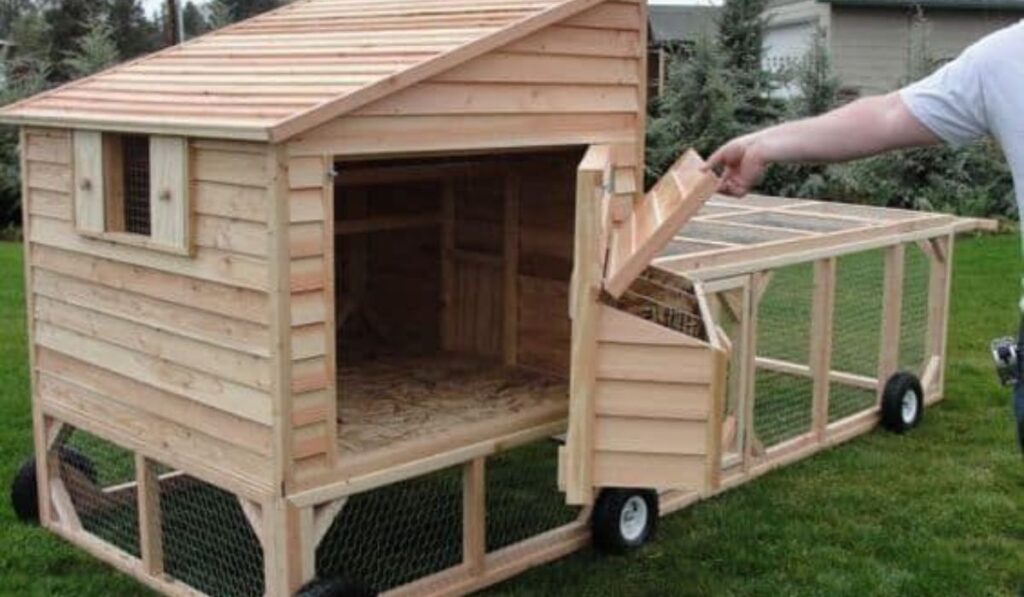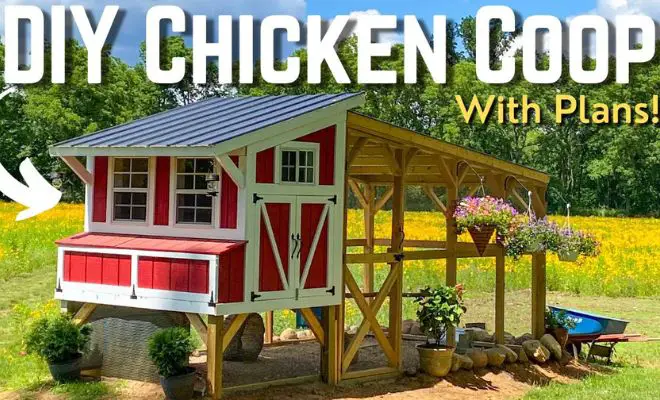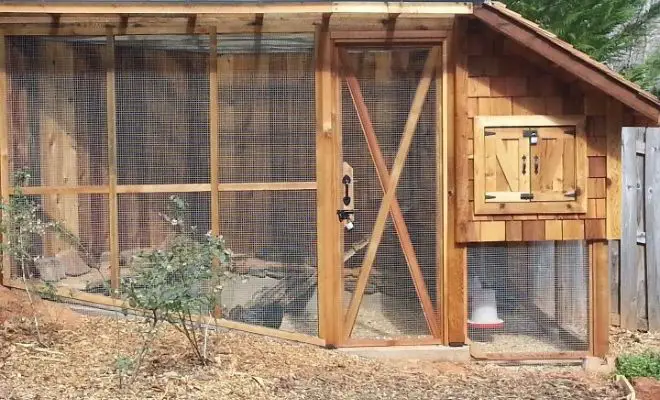
When you start with chicken farming, building a DIY mobile chicken tractor is a clever way to raise them. This movable coop lets chickens munch on fresh grass and keeps them safe from predators and bad weather.
But How to Build Mobile Chicken Tractor? Build a big boxy frame with wood. Add a floor inside the frame. Make a separate chicken wire enclosure for playtime. Build a smaller coop inside for sleeping and nesting. Remember a hinged door for you to access the coop. Also, add wheels, and nest boxes with feeders and waterers.
Simple instructions and easy-to-find materials make your DIY mobile chicken tractor much easier! So, grab your tools, get ready to work, and lemme share the guides to make it.
Table of Contents
How to Build a Mobile Chicken Tractor? 10 Guides to Follow!

Mobile chicken tractors or chicken coops on wheels are a great way to provide a fresh pasture. Here’s a detailed breakdown of how to build one:
#Step 1. Planning and Design
Consider the number of chickens you have and how much space they need to roam comfortably.
A good rule of thumb is 8-10 square feet per chicken for the run (mobile part). Also, you need 4 square feet per chicken for the coop (stationary part) inside the tractor.
#Step 2. Gather Materials and Tools
The best part of this DIY project is, you can use recycled products. Here’s a general list.
- Wood: 2x3s or 2x4s for the frame, plywood for the floor and coop walls.
- Hardware: Screws, nails, hinges, casters (wheels).
- Chicken wire: For the run enclosure.
- Roofing material: Tin, tarp, or shingles.
- Optional: PVC pipes for feeders and waterers, nesting boxes.
- Design Variations: There are two main designs:
- Simple Frame with Run: This is a basic coop with a framed attached run covered in chicken wire.
- Split Coop and Run: This design has a separate coop section with a roof that can be accessed from the run for easy cleaning and egg collection.
Tools:
- Saw
- Drill
- Hammer
- Tape measure
- Pencil
#Step 3. Frame Construction
Cut lumber according to your design. Assemble the frame for the base and the coop using screws and nails. Make sure everything is square and level.
The tractor’s base needs to be 5 feet wide and 6 feet 8 inches long. It’s shorter at the front, taller at the back, and reaches its highest point on the sloped roof. Thick timbers measuring 4 inches by 4 inches by 10 feet serve as the base runners. Welded wire keeps predators out and the birds in.
Keep these things in mind!
#Step 4. Floor and Walls
Attach plywood sheets to the floor frame. For the coop section, attach plywood to the frame to create walls. But does a chicken tractor need a floor always?
No, a chicken tractor traditionally does not need a floor.
The main purpose of a chicken tractor is to allow chickens to graze on fresh grass, bugs, and other goodies found in the dirt. A floor would prevent this natural behavior.
However, there are some situations where a floor might be considered.
Some chicken owners prefer a floor for chicks under 6 weeks old for easier movement. It’s during relocation and protection from drafts. You can use a temporary floor-like hardware cloth during this stage.
If your area has persistent predators, a wire mesh skirt around the base of the tractor is okay!
#Step 5. Run Enclosure
Build the frame for the run using your chosen design. Attach chicken wire to the entire run frame, ensuring no gaps for predators.
#Step 6. Roof
Construct the roof trusses and secure them to the frame. Cover the roof with your chosen roofing material.
#Step 7. Coop Interior

Make the coop look creative and comfortable for the chickens! Here’s where you can get creative.
Install nesting boxes inside the coop for egg-laying. Create a roosting area with perches at varying heights for the chickens to sleep on.
Also, attach feeders and waterers inside the coop, PVC pipes are a good option as they are easy to clean.
#Step 8. Door
Create a door for the coop section for easy access. Consider a small access door on the run for collecting eggs if your design has a split coop and run.
#Step 9. Set Wheels
Attach casters to the bottom corners of the frame for easy mobility. Make sure the wheels can handle the weight of the coop and chickens.
But, how do you move a chicken tractor? Moving a chicken tractor can be done in different ways. Here’s how you can move it –
Clear the path and make sure the door is closed. If your tractor is light enough, you can move it alone.
But how to lift? Stand next to the tractor, bend your knees, and grab onto a handle or the frame.
And how to move? Lift a bit with your legs, keeping your back straight, and take small steps backward.
For medium tractors, get a friend to help. Stand on opposite sides, grab the frame, and move it together.
If the tractor has a flat bottom, a furniture dolly can help on flat surfaces. For bigger tractors, consider using a vehicle. Attach a rope securely and pull slowly with a tractor, ATV, or car.
How often do you move chicken tractor? The ideal frequency depends on the size of your tractor and flock. However, typically you’d move a chicken tractor every 1-3 days. Watch for bare patches or manure buildup to know it’s time to move.
Check some general tips to move the tractor!
Move the tractor when the chickens are relaxed, like early morning or evening. Move carefully to avoid accidents or tipping.
Uneven or muddy terrain can make it harder to move. If the tractor has wheels, make sure they’re high enough to keep chickens from getting underneath.
#Step 10. Finishing Touches
Paint or stain the wood for weatherproofing and aesthetics (optional).
Add a layer of bedding material like wood shavings or hay to the coop floor for comfort and insulation.
Get more ideas from the following video!
How Much Does It Cost to Build A Chicken Tractor?
The cost of building a chicken tractor can vary depending on several factors like – size, materials used, and features. Here’s a table with estimated costs for different categories:
| Category | Cost Range (USD) | Notes |
|---|---|---|
| Lumber | $50 – $200 | Depends on the size and type of wood (treated vs untreated). Recycled lumber can significantly reduce costs. |
| Hardware | $20 – $50 | Screws, nails, hinges, casters. |
| Chicken Wire | $20 – $75 | Varies depending on length and quality. |
| Roofing | $10 – $50 | Options include tin, tarp, or shingles. Recycled materials might be suitable. |
| Coop Interior | $10 – $50 | Nesting boxes, perches, feeders, and waterers. PVC pipes are a budget-friendly option. |
| Wheels | $20 – $100 | Casters vary in weight capacity and quality. |
Advantages and Disadvantages: Why Use A Chicken Tractor or Not?

Chicken tractors offer a unique way to raise chickens, but they come with both benefits and drawbacks. Let’s see what’s good and bad in it –
Advantages of Mobile Chicken Tractor
- Fresh Pasture: A tractor allows them to forage naturally and provides a constantly renewed patch of land.
- Improved Egg Quality: A healthier diet from foraging can lead to tastier eggs with deeper yolks.
- Natural Behavior: Scratching in the dirt is a natural instinct for chickens, helping them bathe, control pests, and find food. A tractor allows this behavior.
- Fertilization: Chicken manure is a great natural fertilizer. By moving the tractor frequently, the manure gets distributed, enriching your soil.
- Reduced Parasite Burden: Moving the coop regularly helps prevent a build-up of parasites in the soil.
- Weed Control: Chickens love to eat weeds and weed seeds, helping to control unwanted plants in your yard.
Disadvantages of Mobile Chicken Tractor
- Effort Required: Moving the tractor every few days can be physically demanding, especially for larger models.
- Limited Space: Tractors are generally smaller than permanent coops, accommodating fewer chickens.
- Weather Exposure: Chickens in tractors have less protection from harsh weather compared to a stationary coop. You might need to provide additional shelter during extreme conditions.
- Predator Vulnerability: Lightweight tractors might be easier for predators to break into compared to a sturdy coop. Consider a wire mesh skirt around the base for extra security.
- Monitoring Challenges: Chickens in a constantly moving tractor can be harder to monitor for health issues or signs of trouble.
Who Might Not Want a Chicken Tractor?
Not all of you need a chicken tractor! So, here are the points to keep in mind –
- People with limited mobility: Moving the tractor can be physically demanding.
- Those in harsh climates: The open design might not offer enough protection for extreme weather conditions.
- Large flock owners: Tractors are typically smaller and can’t accommodate a large number of chickens.
So, ready to build one? I would say you try these common types of chicken tractors:
- A-Frame Tractor
- Ark Tractor
- Mini Tractor
- Square/Rectangular Tractor
- Triangle Tractor with a triangular profile
- Hoop Tractor
- Pyramid Tractor
Related Articles:
FAQs
Want to hear more about chicken tractors? Here are the queries that you should learn to sharpen your knowledge.
Q. How many chickens can fit in a chicken tractor?
A good guideline is 3-4 square feet per standard-sized chicken.
Q. How many chickens should be in a 4×8 tractor?
For a 4×8 foot chicken tractor, a good rule of thumb is 3-4 square feet per standard-sized chicken. So in a 32 square foot tractor, you could comfortably house 8-10 standard-sized chickens.
Q. Are chicken tractors worth it?
Chicken tractors can be very worthwhile! It’s especially when you want to move your flock regularly to fresh ground and provide them with pesticide-free grass and bugs.
Q. How many chickens should be in a 10×10 chicken tractor?
In a 10×10 foot (100 square foot) chicken tractor, following the guideline of 3-4 square feet per standard chicken, you could house 25-33 standard-sized chickens comfortably.
Q. Can chickens live in a tractor?
Yes, chickens can absolutely live full-time in a chicken tractor. It’s as long as it provides enough space, protection from predators, and nesting boxes.
Q. Can chickens sleep in a chicken tractor?
Yes, chickens can roost and sleep inside a chicken tractor at night. Make sure it has appropriate roosting bars and nesting boxes.
Q. Is a chicken tractor better than a stationary coop?
There are pros and cons to each. A stationary coop offers more protection and easier maintenance. A chicken tractor allows you to move flocks to fresh ground easily.
Conclusion
Building your own DIY mobile chicken tractor is a smart way to start chicken farming. This movable coop lets your chickens enjoy fresh grass and stay safe. Building is simple, create a big wooden frame, add a floor, and make a separate wire enclosure for playtime. Inside, build a cozy coop for sleeping and nesting, with wheels for easy movement.
So, roll up your sleeves, follow the guides, and build your own mobile chicken tractor! Let the chicken enjoy a good time in the tractor aka coop!






